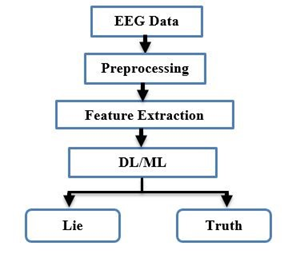A Review on Artificial Intelligence methods and Signal Processing for EEG-Based lie and Truth Identification
DOI:
https://doi.org/10.58564/IJSER.3.2.2024.178Keywords:
Electroencephalogram, Deep learning, Machine learning, lie detectionAbstract
A false statement made with the goal of tricking someone is called a lie. Given how little there is to separate a falsehood from the truth, it can be difficult to tell the two apart. Lying requires more mental effort than telling the truth because the liar has to work hard to make the lie seem believable. When a person feels fear, anxiety, or extreme excitement, their oxygen consumption rate, blood pressure, galvanic skin resistance, and other physiological responses increase significantly. This is the basis for lie detection. In recent years, lie detection techniques have advanced beyond polygraphs to include methods such as electroencephalography, and analysis of eye blink patterns. In this work, we shall institute inspecting accurately Artificial Intelligence (AI) algorithms (Deep learning (DL) and machine learning (ML)) for built for EEG signal processing for lie detection. In this article, we reviewed literature from 2014 to 2023 to take previous and existing classification manner for EEG based-on the lie detection to focus and highlight newest in this field. In this review, we calculating more than 40 papers that utilized AI to EEG data for lie detection. The significance point of this paper is to helping the researchers and those interested in the field of deception detection to develop this field and make him more powerfully and effectively.
References
Institute of Electrical and Electronics Engineers. Region 8, Institute of Electrical and Electronics Engineers., and Vysoké učení technické v Brně. Faculty of Electrical Engineering and Communication, “2020 43rd International Conference on Telecommunications and Signal Processing (TSP) : July 7-9, 2020, Milan, Italy,” p. 702.
Q. Kang, F. Li, and J. Gao, “Exploring the Functional Brain Network of Deception in Source-Level EEG via Partial Mutual Information,” Electronics (Switzerland), vol. 12, no. 7, Apr. 2023, doi: 10.3390/electronics12071633.
N. Saini, S. Bhardwaj, and R. Agarwal, “Classification of EEG signals using hybrid combination of features for lie detection,” Neural Comput Appl, vol. 32, no. 8, pp. 3777–3787, Apr. 2020, doi: 10.1007/s00521-019-04078-z.
A. Bablani, D. R. Edla, V. Kupilli, and R. Dharavath, “Lie Detection Using Fuzzy Ensemble Approach with Novel Defuzzification Method for Classification of EEG Signals,” IEEE Trans Instrum Meas, vol. 70, 2021, doi: 10.1109/TIM.2021.3082985.
M. Zafar-uz-Zaman, National Centre for Physics, Centres of Excellence in Science & Applied Technologies, Institute of Electrical and Electronics Engineers. Islamabad Section, and Institute of Electrical and Electronics Engineers, Proceedings of 2019 16th International Bhurban Conference on Applied Sciences & Technology (IBCAST) : 8th-12th January, 2019.
A. A. AlArfaj and H. A. H. Mahmoud, “A Deep Learning Model for EEG-Based Lie Detection Test Using Spatial and Temporal Aspects,” Computers, Materials and Continua, vol. 73, no. 3, pp. 5655–5669, 2022, doi: 10.32604/cmc.2022.031135.
P. Singh, D. Singh, V. Tiwari, and S. Misra, “Lecture Notes in Electrical Engineering 998 Machine Learning and Computational Intelligence Techniques for Data Engineering.”
M. A. Khalil, J. Can, and K. George, “Deep Learning Applications in Brain Computer Interface Based Lie Detection,” in 2023 IEEE 13th Annual Computing and Communication Workshop and Conference, CCWC 2023, Institute of Electrical and Electronics Engineers Inc., 2023, pp. 189–192. doi: 10.1109/CCWC57344.2023.10099109.
Institute of Electrical and Electronics Engineers and Shenyang shi fan da xue, Proceedings of 2020 IEEE International Conference on Power, Intelligent Computing and Systems : ICPICS 2020 : Shenyang, China, July 28-30, 2020.
G. Junfeng, Q. Jianhui, Z. Wenjia, and Y. Yong, “Feature Optimize and Classification of EEG Signals: Application to Lie Detection Using KPCA and ELM,” 2014. [Online]. Available: http://www.sensorsportal.com
D. R. Edla, S. Dodia, A. Bablani, and V. Kuppili, “An efficient deep learning paradigm for deceit identification test on EEG signals,” ACM Trans Manag Inf Syst, vol. 12, no. 3, Sep. 2021, doi: 10.1145/3458791.
S. Chakrabarti, Institute of Electrical and Electronics Engineers, and I. Institute of Engineering & Management (Kolkata, 2018 IEEE 9th Annual Information Technology, Electronics and Mobile Communication Conference (IEMCON) : 1st-3rd November, 2018, University of British Columbia, Vancouver, Canada.
J. Gao et al., “Deception Decreases Brain Complexity,” IEEE J Biomed Health Inform, vol. 23, no. 1, pp. 164–174, Jan. 2019, doi: 10.1109/JBHI.2018.2842104.
E. D. Farahani and M. H. Moradi, “Multimodal detection of concealed information using Genetic-SVM classifier with strict validation structure,” Inform Med Unlocked, vol. 9, pp. 58–67, 2017, doi: 10.1016/j.imu.2017.05.004.
R. Alomari, M. Vargas Martin, S. MacDonald, and C. Bellman, “Using EEG to Predict and Analyze Password Memorability,” in Proceedings - 2019 IEEE International Conference on Cognitive Computing, ICCC 2019 - Part of the 2019 IEEE World Congress on Services, Institute of Electrical and Electronics Engineers Inc., Jul. 2019, pp. 42–49. doi: 10.1109/ICCC.2019.00019.
S. K. Haider, A. Jiang, M. A. Jamshed, H. Pervaiz, and S. Mumtaz, “Performance Enhancement in P300 ERP Single Trial by Machine Learning Adaptive Denoising Mechanism,” IEEE Networking Letters, vol. 1, no. 1, pp. 26–29, Nov. 2018, doi: 10.1109/lnet.2018.2883859.
A. Arasteh, M. H. Moradi, and A. Janghorbani, “A Novel Method Based on Empirical Mode Decomposition for P300-Based Detection of Deception,” IEEE Transactions on Information Forensics and Security, vol. 11, no. 11, pp. 2584–2593, Nov. 2016, doi: 10.1109/TIFS.2016.2590938.
International Fuzzy Systems Association, Nihon Chinō Johō Fajī Gakkai, M. IEEE Systems, Institute of Electrical and Electronics Engineers, and J. International Conference on Soft Computing and Intelligent Systems (9th : 2017 : Ōtsu-shi, IFSA SCIS 2017 : the 17th World Congress on International Fuzzy Systems Association and the 9th International Conference on Soft Computing and Intelligent Systems : June 27-30, 2017, Otsu, Japan.
A. V. Nair, K. M. Kumar, and J. Mathew, “An Improved Approach for EEG Signal Classification using Autoencoder,” in Proceedings of the 2018 8th International Symposium on Embedded Computing and System Design, ISED 2018, Institute of Electrical and Electronics Engineers Inc., Jul. 2018, pp. 6–10. doi: 10.1109/ISED.2018.8704011.
S. Dodia, D. R. Edla, A. Bablani, and R. Cheruku, “Lie detection using extreme learning machine: A concealed information test based on short-time Fourier transform and binary bat optimization using a novel fitness function,” Comput Intell, vol. 36, no. 2, pp. 637–658, May 2020, doi: 10.1111/coin.12256.
D. E. Kusumandari, A. Turnip, M. Faizal Amri, and M. A. Suhendra, “Lie Detection Based EEG-P300 Signal Classified by ANFIS Method,” 2017, [Online]. Available: https://www.researchgate.net/publication/342198879
S. Kamran Haider, A. Jiang, Z. Khan, and M. Imran Daud, “Evaluation of P300 based Lie Detection Algorithm,” Electrical and Electronic Engineering, vol. 2017, no. 3, pp. 69–76, 2017, doi: 10.5923/j.eee.20170703.01.
A. Turnip, M. F. Amri, H. Fakrurroja, A. I. Simbolon, M. A. Suhendra, and D. E. Kusumandari, “Deception detection of EEG-P300 component classified by SVM method,” in ACM International Conference Proceeding Series, Association for Computing Machinery, Feb. 2017, pp. 299–303. doi: 10.1145/3056662.3056709.
Y. F. Lai, M. Y. Chen, and H. Sen Chiang, “Constructing the lie detection system with fuzzy reasoning approach,” Granular Computing, vol. 3, no. 2, pp. 169–176, Jun. 2018, doi: 10.1007/s41066-017-0064-3.
A. Bablani, D. R. Edla, V. Kuppili, and D. Ramesh, “A multi stage EEG data classification using k-means and feed forward neural network,” Clin Epidemiol Glob Health, vol. 8, no. 3, pp. 718–724, Sep. 2020, doi: 10.1016/j.cegh.2020.01.008.
S. Dodia, D. R. Edla, A. Bablani, D. Ramesh, and V. Kuppili, “An efficient EEG based deceit identification test using wavelet packet transform and linear discriminant analysis,” J Neurosci Methods, vol. 314, pp. 31–40, Feb. 2019, doi: 10.1016/j.jneumeth.2019.01.007.
A. Bablani, D. Reddy Edla, and V. Kuppili, “Deceit Identification Test on EEG Data using Deep Belief Network.”
A. Bablani, D. R. Edla, D. Tripathi, and K. Venkatanareshbabu, “Subject based Deceit Identification using Empirical Mode Decomposition,” in Procedia Computer Science, Elsevier B.V., 2018, pp. 32–39. doi: 10.1016/j.procs.2018.05.056.
M. Daneshi Kohan, A. Motie NasrAbadi, A. sharifi, and M. Bagher Shamsollahi, “Interview based connectivity analysis of EEG in order to detect deception,” Med Hypotheses, vol. 136, Mar. 2020, doi: 10.1016/j.mehy.2019.109517.
V. Boddu and P. Kodali, “PSO-based optimization for EEG data and SVM for efficient deceit identification,” Soft comput, vol. 27, no. 14, pp. 9835–9843, Jul. 2023, doi: 10.1007/s00500-023-08476-3.
S. Wei et al., “Analysis of Weight-Directed Functional Brain Networks in the Deception State Based on EEG Signal,” IEEE J Biomed Health Inform, vol. 27, no. 10, pp. 4736–4747, Oct. 2023, doi: 10.1109/JBHI.2023.3295892.
J. Gao, H. Tian, Y. Yang, X. Yu, C. Li, and N. Rao, “A novel algorithm to enhance P300 in single trials: Application to lie detection using F-score and SVM,” PLoS One, vol. 9, no. 11, Nov. 2014, doi: 10.1371/journal.pone.0109700.
IEEE Staff, 2018 International Conference on Computer Communication and Informatics (ICCCI). IEEE, 2018.
2015 International Conference on Automation, Cognitive Science, Optics, Micro Electro-Mechanical System, and Information Technology (ICACOMIT). IEEE, 2015.
A. Bablani, D. R. Edla, and S. Dodia, “Classification of EEG data using k-nearest neighbor approach for concealed information test,” in Procedia Computer Science, Elsevier B.V., 2018, pp. 242–249. doi: 10.1016/j.procs.2018.10.392.
S. Thakur, R. Dharavath, and D. R. Edla, “Spark and Rule-KNN based scalable machine learning framework for EEG deceit identification,” Biomed Signal Process Control, vol. 58, Apr. 2020, doi: 10.1016/j.bspc.2020.101886.
Y. Xiong, Y. Luo, W. Huang, W. Zhang, Y. Yang, and J. Gao, “A novel classification method based on ICA and ELM: A case study in lie detection,” in Bio-Medical Materials and Engineering, 2014, pp. 357–363. doi: 10.3233/BME-130818.
Institute of Electrical and Electronics Engineers, IEEE Robotics and Automation Society. Malaysia Chapter, and Universiti Teknologi MARA. Centre of Excellence Humanoid Robots and Bio-Sensing, IEEE IRIS 2015 : 2015 IEEE International Symposium on Robotics and Intelligent Sensors : symposium digest : 18-20 October 2015, Berjaya Langkawi Resort, Malaysia.
IEEE Control Systems Society. Chapter Malaysia and Institute of Electrical and Electronics Engineers, Proceeding, 2016 IEEE 12th International Colloquium on Signal Processing & Its Applications : (CSPA2016) : 4-6 March 2016, Hatten Hotel, Hatten Square, Jalan Merdeka, Bandar Hilir, 7500 Melaka, Malaysia.
V. Gupta, M. Agarwal, M. Arora, T. Chakraborty, R. Singh, and M. Vatsa, “Bag-of-Lies: A Multimodal Dataset for Deception Detection.” [Online]. Available: http://iab-rubric.
Riyadh Salam Mohammed and Ammar A. Al-Hamadani, “Electroencephalographic (EEG) based Deep Learning (DL): A Comparative Review,” Al-Iraqia Journal of Scientific Engineering Research, vol. 2, no. 1, Mar. 2023, doi: 10.58564/ijser.1.2.2023.70.
M. Z. Al-Faiz and A. A. Al-Hamadani, “ANALYSIS AND IMPLEMENTATION OF BRAIN WAVES FEATURE EXTRACTION AND CLASSIFICATION TO CONTROL ROBOTIC HAND,” 2018. [Online]. Available: https://ijict.edu.iq

Downloads
Published
Issue
Section
License
Copyright (c) 2024 Hamza Waleed Hamza, Ammar A. Al-Hamadani

This work is licensed under a Creative Commons Attribution-ShareAlike 4.0 International License.









